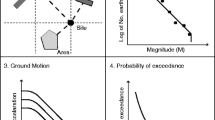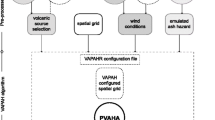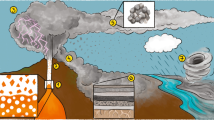Abstract
Volcanic ash is one of the farthest-reaching volcanic hazards and ash produced by large magnitude explosive eruptions has the potential to affect communities over thousands of kilometres. Quantifying the hazard from ash fall is problematic, in part because of data limitations that make eruption characteristics uncertain but also because, given an eruption, the distribution of ash is then controlled by time and altitude-varying wind conditions. Any one location may potentially be affected by ash falls from one, or a number of, volcanoes so that volcano-specific studies may not fully capture the ash fall hazard for communities in volcanically active areas. In an attempt to deal with these uncertainties, this paper outlines a probabilistic framework for assessing ash fall hazard on a regional scale. The methodology employs stochastic simulation techniques and is based upon generic principles that could be applied to any area, but is here applied to the Asia-Pacific region. Average recurrence intervals for eruptions greater than or equal to Volcanic Explosivity Index 4 were established for 190 volcanoes in the region, based upon the eruption history of each volcano and, where data were lacking, the averaged eruptive behaviour of global analogous volcanoes. Eruption histories are drawn from the Smithsonian Institution’s Global Volcanism Program catalogue of Holocene events and unpublished data, with global analogues taken from volcanoes of the same type category: Caldera, Large Cone, Shield, Lava dome or Small Cone. Simulated are 190,000 plausible eruption scenarios, with ash dispersal for each determined using an advection–diffusion model and local wind conditions. Key uncertainties are described by probability distributions. Modelled results include the annual probability of exceeding given ash thicknesses, summed over all eruption scenarios and volcanoes. A companion paper describes the results obtained for the Asia-Pacific region








Similar content being viewed by others
References
Arnold M, Dilley M, Deichmann U, Chen RS, Lerner-Lam AL (2005) Natural disaster hotspots: a global risk analysis. In: Disaster risk management 5. World Bank: Washington, DC. pp 1–145
Bacon CR (1982) Time-predictable bimodal volcanism in the Coso Range, California. Geology 10(2):65–69
Bebbington M, Cronin S (2011) Spatio-temporal hazard estimation in the Auckland Volcanic Field, New Zealand, with a new event-order model. Bull Volcanol 73(1):55–72
Blong RJ (1984) Volcanic hazards: a sourcebook on the effects of eruptions. Academic, Australia, pp 1–424
Bonadonna C, Connor CB, Houghton BF, Connor L, Byrne M, Laing A, Hincks TK (2005) Probabilistic modeling of tephra dispersal: hazard assessment of a multiphase rhyolitic eruption at Tarawera, New Zealand. J Geophys Res 110(B03203):1–21
Carey S, Sigurdsson H (1989) The intensity of plinian eruptions. Bull Volcanol 51(1):28–40
Coles SG, Sparks RSJ (eds) (2006) Extreme value methods for modelling historical series of large volcanic magnitudes. Special Publications of IAVCEI, Geological Society, London
Connor CB, Hill BE, Winfrey B, Franklin NM, La Femina PC (2001) Estimation of volcanic hazards from tephra fallout. Nat Hazards Rev 2(1):33–42
Ewert JW (2007) System for ranking relative threats of U.S. volcanoes. Nat Hazards Rev 8(4):112–124
Ho C-H (1990) Bayesian analysis of volcanic eruptions. J Volcanol Geotherm Res 43(1–4):91–98
Hoblitt RP, Miller CD, Scott WE (1987) Volcano hazards with regard to siting nuclear power-plants in the Pacific Northwest. United States Geological Survey open-file report 87–297
Hurst AW (1994) ASHFALL, a computer program for estimating volcanic ash fallout: report and users guide. Institute of Geological & Nuclear Sciences Science Report 94
Hurst T, Smith W (2004) A Monte Carlo methodology for modelling ashfall hazards. J Volcanol Geotherm Res 138(3–4):393–403
Jenkins SF, Magill CR, McAneney KJ (2007) Multi-stage volcanic events: a statistical investigation. J Volcanol Geotherm Res 161(4):275–288
Jenkins S, Magill C, McAneney J, Hurst AW (2008) Multi-stage volcanic events: tephra hazard simulations for the Okataina Volcanic Center, New Zealand. J Geophys Res (Earth Surface) 113(F04012)
Jenkins S, McAneney J, Magill C, Blong R (2012) Regional ash fall hazard II: Asia-Pacific modelling results and implications. Bull Volcanol. doi:10.1007/s00445-012-0628-7
Klein FW (1984) Eruption forecasting at Kilauea volcano, Hawaii. J Geophys Res 89(B5):3059–3073
Macedonio G, Costa A, Folch A (2008) Ash fallout scenarios at Vesuvius: numerical simulations and implications for hazard assessment. J Geophys Res 178(3):366–377
Machida H, Arai F (1992) Atlas of tephra in and around Japan. University of Tokyo Press (in Japanese), Tokyo, pp 1–276
Magill C, Blong R (2005) Volcanic risk ranking for Auckland, New Zealand. II: hazard consequences and risk calculation. Bull Volcanol 67(4):340–349
Marzocchi W, Zaccarelli L (2006) A quantitative model for the time–size distribution of eruptions. J Geophys Res 111(B4):B04204
Nairn IA (2005) Volcanic hazards at Okataina Volcanic Centre. GNS Science
Newhall CG, Self S (1982) The volcanic explosivity index (VEI)—an estimate of explosive magnitude for historical volcanism. J Geophys Res 87:1231–1238
Newhall CG, Bronto S, Alloway B, Banks NG, Bahar I, del Marmol MA, Hadisantono RD, Holcomb RT, McGeehin J, Miksic JN, Rubin M, Sayudi SD, Sukhyar R, Andreastuti S, Tilling RI, Torley R, Trimble D, Wirakusumah AD (2000) 10,000 years of explosive eruptions of Merapi Volcano, Central Java: archaeological and modern implications. J Volcanol Geotherm Res 100(1–4):9–50
Oak Ridge National Laboratory (2005) LandScanTM Global Population Database
Siebert L, Simkin T (2002-) Volcanoes of the world: an illustrated catalog of Holocene volcanoes and their eruptions. Smithsonian Institution, Global Volcanism Program digital information series, GVP-3. (http://www.volcano.si.edu/world/)
Simkin T (1993) Terrestrial volcanism in space and time. Annu Rev Earth Planet Sci 21:427–452
Simkin T, Fiske R (1983) Krakatau 1883: the volcanic eruption and its effects. Smithsonian Institution Press, New York
Simkin T, Siebert L (1994) Volcanoes of the world. Geoscience Press, Tucson, pp 1–349
Small C, Naumann T (2001) The global distribution of human population and recent volcanism. Global Environ Chang Part B: Environ Hazards 3(3–4):93–109
Spence R, Gunesekara R, Zuccaro G (2009) Insurance risks from volcanic eruptions in Europe. WRN Research Bulletin, Willis Research Network
Thouret J-C, Lavigne F, Kelfoun K, Bronto S (2000) Toward a revised hazard assessment at Merapi volcano, Central Java. J Volcanol Geotherm Res 100(1–4):479–502
Voight B, Constantine EK, Siswowidjoyo S, Torley R (2000) Historical eruptions of Merapi Volcano, Central Java, Indonesia, 1768–1998. J Volcanol Geotherm Res 100(1–4):69–138
Woods AW, Bursik MI (1991) Particle fallout, thermal disequilibrium and volcanic plumes. Bull Volcanol 53:559–570
Yokoyama I, Tilling R, Scarpa R (1984) International mobile early-warning system(s) for volcanic eruptions and related seismic activities. FP/2106-82-01 (2286), UNESCO, Paris
Acknowledgments
The authors would like to thank Lee Siebert (Smithsonian Institution) for providing unpublished data and for helpful discussions regarding volcano type categorisation and Tony Hurst (GNS Science) for the ASHFALL source code. We also sincerely thank Costanza Bonadonna and Warner Marzocchi for providing detailed and very valuable reviews of the manuscripts and the editors of Bulletin of Volcanology for their support. This research was carried out while Susanna Jenkins was holding an International Macquarie University Research Scholarship.
Author information
Authors and Affiliations
Corresponding author
Additional information
Editorial responsibility: J.C. Phillips
Appendix 1
Appendix 1
Description of terms, acronyms and mathematical notation
- AEP:
-
Annual exceedance probability
- ARI:
-
Average recurrence interval—approximate inverse of the annual exceedance probability
- ASHFALL:
-
Semi-analytical two-dimensional ash dispersion model developed by GNS Science, New Zealand
- Global eruption database:
-
The Smithsonian Institution’s Global Volcanism Program catalogue of Holocene events supplemented with further unpublished records
- λ:
-
Averaged annual eruption probability
- T :
-
Time period over which eruption catalogue is thought to be complete
- VEI:
-
Volcanic explosivity index
Rights and permissions
About this article
Cite this article
Jenkins, S., Magill, C., McAneney, J. et al. Regional ash fall hazard I: a probabilistic assessment methodology. Bull Volcanol 74, 1699–1712 (2012). https://doi.org/10.1007/s00445-012-0627-8
Received:
Accepted:
Published:
Issue Date:
DOI: https://doi.org/10.1007/s00445-012-0627-8




